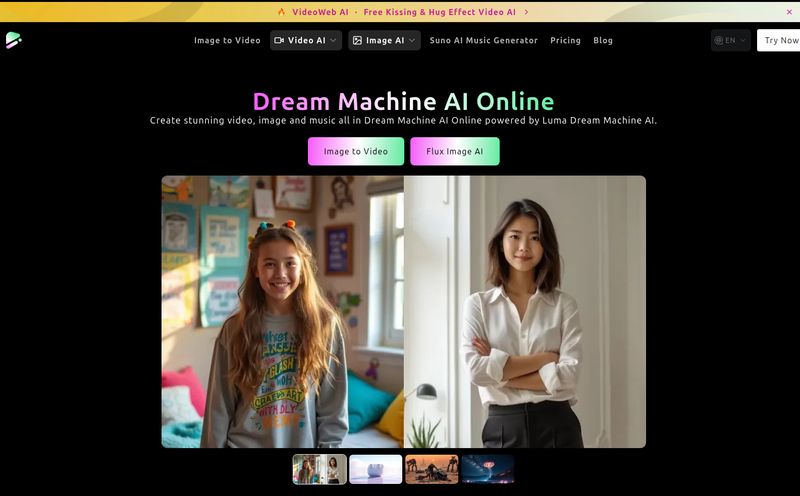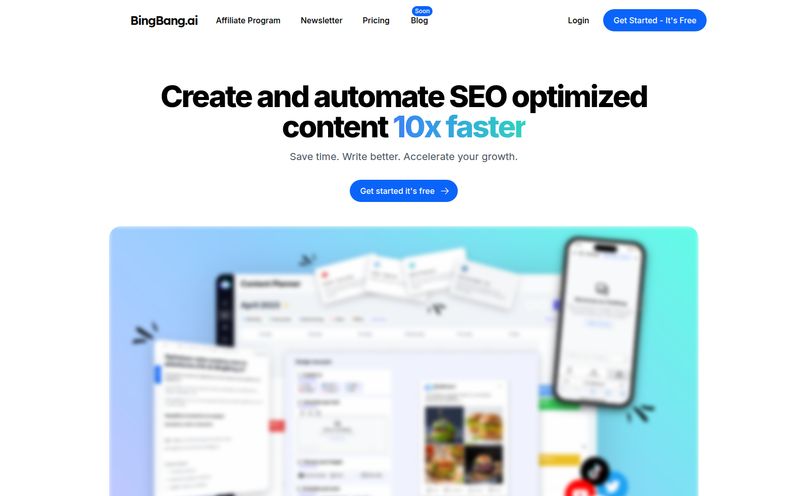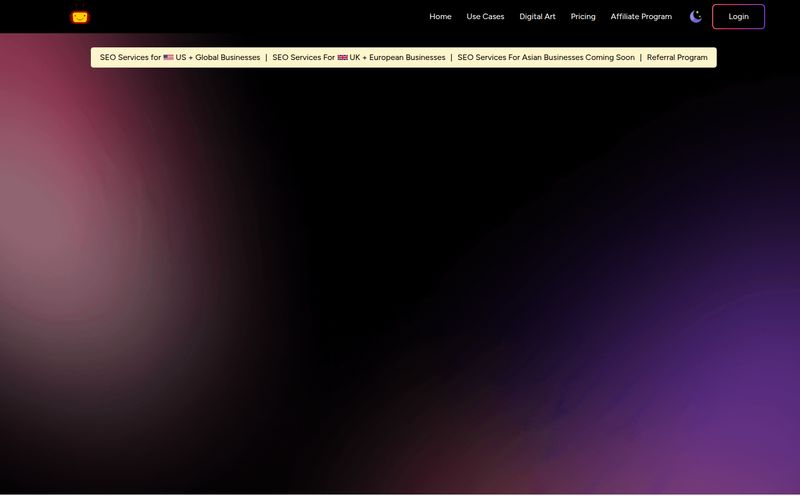I’ve got a confession to make. My desk is littered with notebooks full of... well, let's call them 'conceptual scribbles.' You know the type. A brilliant idea for a logo strikes in a meeting, so you quickly sketch it on a sticky note. Or you have a vision for a blog graphic, but your drawing skills peaked in the third grade. These ideas, full of potential, usually end up in a drawer, a graveyard of good intentions. They’re too rough to show a client, too messy to become anything real. It's a classic creative bottleneck.
For years, the bridge between a raw sketch and a polished digital asset was a long, expensive one, usually involving a graphic designer and a lot of back-and-forth. But we're living in the middle of an AI gold rush, and tools are popping up that promise to shorten that bridge. Or maybe even replace it with a teleporter. One of those tools that recently landed on my radar is Sketch AI. The promise is simple, almost deceptively so: turn your sketch into a professional-quality digital design. Simple.
But as anyone in the SEO and digital marketing world knows, 'simple' promises are often the most complicated. So, I decided to take it for a spin. Does it work? Is it magic? Or is it just another gimmick in the ever-crowded AI space? Let's get into it.
What on Earth is Sketch AI, Anyway?
At its core, Sketch AI is an AI art generator, but with a specific twist. Unlike Midjourney or DALL-E where you type text prompts like “an astronaut riding a flamingo on Mars, photorealistic,” Sketch AI starts with a visual prompt. Your visual prompt. You either draw something on paper and snap a photo, or sketch directly within their app/website.
Then, the AI takes over. It analyzes the lines, shapes, and general composition of your doodle and transforms it into a fully rendered piece of digital art, a stock photo, or a clean graphic. Think of it like having a professional illustrator on standby, ready to interpret your napkin doodles and turn them into something polished. It’s an intriguing proposition, especially for people like me who are more 'idea people' than 'execution artists.'

Visit Sketch AI
My First Run-Through and User Experience
Hopping onto the platform, the first thing I noticed was the clean interface. No-nonsense. It’s not trying to overwhelm you with a million buttons and sliders, which I appreciate. The digital marketing space is already cluttered enough, thank you very much. The main focus is a canvas, beckoning you to start drawing.
I decided to go old-school. I drew a very, very basic outline of a coffee cup with steam rising from it on a piece of printer paper. Something you might sketch out for a new café logo. I snapped a pic with my phone and uploaded it. After a few seconds of processing—the digital equivalent of a drumroll—it spat out a few variations. One was a photorealistic coffee cup on a wooden table. Another was a slick, minimalist vector icon. A third was a more stylized, painterly version.
Honestly? I was impressed. It wasn't perfect, but the leap from my shaky-handed doodle to these outputs was genuinely startling. The potential was immediately obvious.
The Core Features That Actually Matter
A tool can have a hundred features, but usually, only a few make or break the experience. Here’s what stood out with Sketch AI.
The AI Sketch-to-Image Magic
This is the main event, the whole reason the tool exists. The technology is clearly sophisticated. It doesn't just color within your lines; it interprets intent. It saw my squiggly lines for steam and understood it should render it as soft, ethereal vapor. However, this leads to the tool's biggest caveat, something we old-timers in tech call GIGO: Garbage In, Garbage Out. The quality and clarity of your initial sketch heavily influence the result. A vague, muddy sketch will produce a vague, muddy output. A clear, intentional sketch with defined shapes will give the AI much better direction and yield far superior results. So, while you don't need to be Leonardo da Vinci, a little effort upfront goes a long way.
A Palette of Creative Tools
The platform isn't just a black box. It provides a variety of brushes and colors if you choose to sketch directly on the platform. This gives you more control over the initial input. You can hint at color schemes or textures right in the sketch phase, which helps guide the AI more effectively than a simple monochrome drawing. It’s a nice touch that gives the user a bit more creative direction.
The All-Important Editing Tools
Once the AI has worked its magic, you're not just stuck with what it gives you. Sketch AI includes a range of editing tools to perfect the final image. This is crucial. I've found that AI-generated images often get you 90% of the way there. That last 10%—a slight color tweak, cropping, or sharpening an edge—is what separates a usable asset from a near-miss. Having these tools built-in saves you from having to immediately export the image to another program like Photoshop or Canva for minor adjustments.
So, Who Is This Actually For?
While any artist or hobbyist could have a field day with this, I see its real power in the professional world, for people who aren't necessarily professional artists.
- Marketers and Social Media Managers: Need a unique graphic for a campaign, right now? Sketch out your idea for a promotional banner or an Instagram post and get a high-quality visual in minutes. It's a way to break free from the same old stock photos everyone else is using.
- Founders and Entrepreneurs: You have a logo idea but no budget for a designer yet. Sketch it out. Mock up a user interface for your app idea. Visualize a product concept. It's a fantastic tool for rapid prototyping and iteration.
- Content Creators and Bloggers: I'm looking right in the mirror here. Creating custom blog headers and featured images is a constant chore. The ability to sketch a concept and get a unique, relevant image is a massive time-saver.
The Good, The Bad, and The... Sketchy
No tool is perfect. Let's be real. The overall experience with Sketch AI is overwhelmingly positive. The 'wow' factor of seeing your scribbles come to life is undeniable, and the speed is a huge advantage in a fast-paced work environment. It’s incredibly user-friendly and lowers the barrier to creating custom visuals.
However, the reliance on the initial sketch is both a strength and a weakness. It ensures the output is true to your vision, but it also means a bad sketch can't be magically saved. You still need a clear idea. Furthermore, you’ll likely need to do some light editing on the final image to get it just right. It's not quite a one-click-and-done solution, but it’s damn close.
What's the Damage? A Look at Pricing
Here’s the million-dollar question. As of writing this, I couldn't find a clear, public pricing page. This is pretty common for new AI tools that are either in beta or still figuring out their monetization strategy. It could be a freemium model (a certain number of free generations per month), a subscription-based plan, or a pay-per-image system. My advice? Head over to their website to check for the most current information. Many of these tools offer a free trial, which should be more than enough to see if it fits your workflow.
The Verdict: Is Sketch AI a Game-Changer?
Look, Sketch AI isn't going to replace high-end graphic designers for complex, bespoke projects. But it was never meant to. Its genius lies in a different area. It's a tool for ideation, for rapid visualization, and for empowering non-artists to bring their creative visions to life quickly and affordably.
For my money, it's one of the most practical and focused AI tools I've seen recently. It solves a very specific, very common problem. It democratizes a piece of the creative process, taking those brilliant ideas out of the notebook-graveyard and putting them on the screen where they belong. And for that, it earns a definite recommendation from this old SEO blogger. Go give it a try. You might be surprised what your doodles are capable of.
Frequently Asked Questions about Sketch AI
- Is Sketch AI free to use?
- At the time of this review, clear public pricing wasn't available. Many new AI tools offer a free trial or a freemium tier, but you should check the official Sketch AI website for the most up-to-date pricing information.
- Do I need to be a good artist to use Sketch AI?
- Not at all! You don't need to be a professional artist, but a clear, well-defined sketch will produce better results than a messy or vague one. Think simple shapes and clear intentions.
- What kind of images can I create with Sketch AI?
- You can generate a wide range of images, including photorealistic stock photos, digital artwork, vector-style graphics, mockups, and more. The style of the output can often be guided by your prompts or the tool's settings.
- How does Sketch AI differ from Midjourney or DALL-E?
- The main difference is the input. Tools like Midjourney rely on text prompts, where you describe an image with words. Sketch AI uses a visual prompt—your drawing. This makes it ideal for when you have a specific composition in mind that's easier to draw than to describe.
- Can I use the images I create for commercial purposes?
- This typically depends on the platform's terms of service. Most AI art generators have specific policies regarding commercial use, which often vary between free and paid plans. It is absolutely essential to read their terms to ensure you have the proper rights for your intended use.
References and Sources
- For more information directly from the source, visit the Sketch AI official website.
- To understand the broader context of AI in creative fields, this article from Forbes provides some interesting perspectives on generative AI and creativity.



